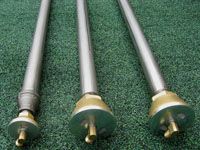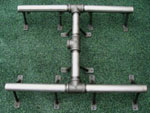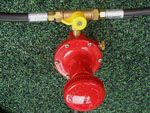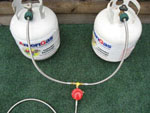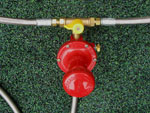Meats and Sausages
Smokehouse Pipe Burners
Smokehouse pipe burners made by Tejas Smokers are ideally suited for heating large smokehouses and will supply a reliable, continuous source of fuel. Tejas Smokers HPGX-1 venturi with the ¾” F NPT inlet can be configured for high or low-pressure propane or natural gas depending on the choice of orifice and type of air shutter used. It has been used for high-powered torches in kilns and furnaces and, on the other end of the heat spectrum, for relatively low-heat applications in smokehouses.
HPGH-2 burner shown with a 12” pipe nipple, however, the burner seems to work equally well with a 4” pipe nipple “throat” as with a 10’ pipe nipple “throat.” This burner can develop a maximum of approximately 160,000 btu/hr.
A higher heat output than the HPGX-2, the much larger HPMAX-2 can develop a maximum heat output of approximately 225,000 btu/hr. This larger version weighs 2.5 times as much and uses a 1 ¼” pipe nipple between the burner head and venturi. The larger venturi HPMAX-1 has become an integral part of Tejas Smokers high heat pipe burner product line.
It turns out that if you are making a pipe burner by hand it is a heck of a lot easier to drill into 1 ¼” ID steel pipe than it is to drill into ¾” ID steel pipe. Try it yourself. The larger 1 ¼” steel pipe is much easier to drill into when drilling holes manually. The flames are even from one end to the other and they self-ignite, i.e., the flames jump from one hole to the next when being first lit. A computer programmed CNC machine makes the various length pipe burners almost automatically.
Fuel is not cheap anymore. You just can’t afford to waste it. Your burners need to be efficient and give blue flames with little or no yellow in the flame. Tejas burners efficiently heat all sorts of large roasters like hog roasters and corn roasters.
Here you see several pipe burners: With natural gas and low-pressure propane, the HPGX-1 venturi just does the job a little better than its big brother HPMAX-1. However, if you are really needing the high btu/hr, then stay with the HPMAX-1 and high-pressure propane. In either case, we still prefer to use the 1 ¼”ID steel pipe. Notice that we bush up to the 1 ¼” ID pipe immediately from the HPGX-1 venturi. A well-built pipe burner will give you even heating across the flame length.
When the fuel is propane at high pressure these burners can develop so much heat that they will bend and curl. Depending on the application and the heat being developed we often recommend that the pipe burners rest in a cradle like that shown:
It is not enough to just lay the pipe burner in this type of cradle. The ends of the burner should be clamped as well. A U-bolt near both ends of the pipe will serve that purpose very well.
Some folks building vertical smokehouses have requested “H-burners”. They want one source of fuel going into the smokehouse and they want the heating to be even and relatively low. There is not just one “right” way to do it.
We provide a lot of outdoor cooking equipment to professional and semi-professional caterers and chefs. A common requirement they all have is a reliable, continuous source of fuel. Most caterers must use propane, be it high pressure or low pressure, they are using propane out of tanks. Many smokehouses are in the same situation. We designed a manual changeover valve that allows one to switch from one propane tank to another effortlessly. Let’s face it, many of us are a bit lazy. When we run out of gas we don’t always want to change the tanks right then and there. It is easier to just flip a lever and go back to what we were doing.
The setup comes with two thermoplastic 24” long high-pressure hoses with wrenchless Acme type I tank connectors. When one tank empties you just turn the lever towards the full tank. Then you can remove the empty tank and replace it with a full one. This valve system will attach to ANY propane regulator, high pressure or low pressure.
We also offer this setup with stainless steel overbraid hoses. Some parts of the country are in “squirrel country” and those rodents get intoxicated by the smell of propane and natural gas. It gets them in the gnawing mode and you tend to lose your gas line when you least can afford to lose it. These stainless steel overbraid hoses put an end to that nonsense.
More on pipe burners
Disclaimer
The information provided in this chapter on making your own burners and installing your own gas heating systems is for educational purposes only. Gas systems of any kind are very dangerous, and the actual work involved in making or assembling any components or the whole system should be performed by a qualified and licensed plumber or contractor only.



